Kathmandu Travel Guide
Presided over by snowy mountains, the Kathmandu Valley sits surrounded by verdant agricultural hills scattered with traditional villages and brick houses. Rich in ancient holy temples and shrines for both Buddhists and Hindus, the area reflects the great wealth of culture and tradition in Nepal.
Most of Nepal's ethnic groups are represented in the Valley, particularly in Kathmandu itself, but the Newars are the original inhabitants, responsible for much of the splendid art and architecture in the cities.
The Kathmandu Valley is the cultural, political, and commercial centre of Nepal and encompasses three cities: Kathmandu, the capital; Patan, which has been enveloped by the growing Kathmandu outskirts; and the medieval city of Bhaktapur.
For the unprepared visitor, the capital city of Kathmandu can trigger a sensory overload. It's a heaving city of intriguing but unpleasant smells, incessant noise and pollution, and sights that etch themselves on the memory.
Cows wander the streets of the old city, while narrow alleyways overflow with spices, vegetables, and handicraft shops. Throngs of people thread their way along bustling cobblestone streets lined with structures from an ancient architectural heritage, leading onto open squares surrounded by temples.
The largest city in Nepal and the nation's historical centre, Kathmandu throws together a blend of the country's varied population and boasts a distinctive, age-old religious influence visible in the daily life of its inhabitants.
Many people choose to stay outside Kathmandu in one of the Valley towns or mountain resorts, restricting their visits to day trips. Otherwise, they base themselves in the tourist-orientated Thamel district of the city, offering modern bakeries, smart hotels, and upmarket restaurants.
Things to do in Kathmandu
Once one of the world's most inaccessible destinations, a holiday in Kathmandu is now very easy to arrange. Many travel to Kathmandu to start expeditions into the rest of the country, as well as to experience its vibrant traditions, preserved architecture, and fascinating Buddhist and Hindu culture.
A holiday in the capital attracts mainly those intent on undertaking adventure trips in Nepal, full of trekking, rafting, and mountain climbing. But the city has its share of diversions and tourist attractions, with more temples and monasteries than any traveller could possibly hope to visit.
Must-see sites include Durbar Square, Pashupatinath Temple, the Swayambhunath Stupa, and the Boudhanath Stupa. There are also many sites close to the city, making for exciting excursions. The city has plenty of restaurants in its Thamel tourist district, and shopping in Kathmandu offers visitors a variety of goods ranging from authentic local handicrafts to religious souvenirs.
There are many shops selling handwoven cotton fabric, clothing, and popular Nepalese souvenirs, including Tibetan carpets, and (scroll paintings), Terai baskets, and traditional rice paper.
Kashmiri shawls, Tibetan robes, and embroidered kaftans are also very popular, and there is a lot of religious paraphernalia for sale at Buddhist sites in Kathmandu. However, the most sought after treasures are the rare lime-green tourmaline gems.
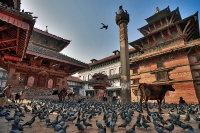
Durbar Square
Protected as a UNESCO World Heritage Site, Durbar Square is the religious and social heart of Kathmandu's old city. Built between the 12th and 18th centuries by the ancient kings of Nepal, it's a complex of palaces, temples, shrines, statues, and courtyards. The square is a queer assortment of the old and the new, its elaborately carved architectural features and curving roofs providing shelter for cows and weary tourists. Brahman priests and painted sadhus perform rituals and pose for photos, while souvenir sellers and rickshaw drivers compete for attention among the crowds. Stone lions guard the gates to the Old Royal Palace, which contains a number of courtyards and houses the Narayanhity Durbar Museum. Set into the palace wall is a 17th-century stone inscription written in 15 languages. It's believed milk will flow from the spout if anyone deciphers the entire inscription.
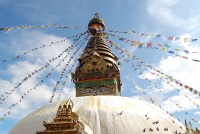
Swayambhunath Stupa
Colourful fluttering prayer flags adorns the golden spire of the 5th-century Swayambhu Stupa. It crowns a hill overlooking the Kathmandu Valley and offers fantastic views over the capital city of Kathmandu. The Swayambhunath Stupa is one of the most recognisable symbols in Nepal, with the painted eyes of the Buddha watching all those who ascend the worn stone steps. A UNESCO World Heritage Site, it is one of the holiest Buddhist sites in Nepal and is at the source of the valley's mythical beginning. Legend has it that the history of the valley began with the draining of an ancient lake by an Enlightened Being, when a lotus flower was transformed into the hill and the shining light became the stupa itself. Also called the Monkey Temple, swarms of pilgrims and red-clad monks circle the complex, spinning the prayer wheels while scores of monkeys that give the temple its nickname prance about in irreverent troupes. The temple complex is scattered with shrines and statues of Buddhist and Hindu deities, and the assortment of pilgrims from both faiths characterises the country's unique religious harmony. Visitors should note that although they are often adorable and entertaining, the monkeys can sometimes become aggressive if visitors have something they want.
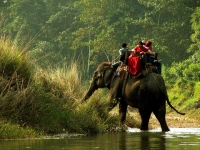
Royal Chitwan National Park
Of the 14 national parks and reserves in Nepal, the Royal Chitwan National Park is the oldest and most popular safari destination for visitors. Situated in the subtropical Tarai lowlands, the jungle is home to endangered animals such as the one-horned rhinoceros and the royal Bengal tiger. Other animals include leopards, wild elephants, Indian bison, sloth bears, crocodiles, pythons, monitor lizards, pangolins, and over 400 species of birds. The terrain is mostly flat, consisting of dense jungle, marsh, and grassland. There's no guarantee of good game sightings, so it is best to spend at least two days in the park. Elephant safaris are the most popular way to explore the park. Jeep safaris, guided walks, overnight jungle expeditions, and canoe trips are also available. There is a wide choice of accommodation, ranging from luxury camps or hotels within the park to budget options on the outskirts. The best place to look for budget accommodation is Sauraha, becoming something of a tourist centre with hotels, restaurants, bars, travel agents, money changing facilities, shops, and even internet cafes. The town has a beautiful setting, sitting on the banks of a wide river in the jungle.
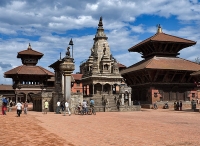
Bhaktapur
Also known as the City of Devotees, Bhaktapur lies just 22 miles (35km) east of Kathmandu. The wealth of fabulous architectural showpieces, soaring pagodas, richly ornamented houses, and medieval layout is testament to the period when the city was the capital of the Kathmandu Valley during the 14th and 16th centuries. The whole town is a UNESCO World Heritage Site filled with palaces, temples, statues, and squares, connected by a maze of largely pedestrian streets. The main Durbar Square boasts many architectural attractions, including the Golden Gate, the 15th-century Palace of 55 Windows, and several statues of ancient kings. Taumadhi Square is presided over by the elegant Nyatapola Temple. Sitting atop a five-story platform, Nyatpola is the tallest pagoda temple in the Kathmandu Valley. Bhaktapur is also the centre of traditional pottery and weaving industries in the region. Visiting Bhaktapur is like stepping back in time, with its largely preserved ancient traditions, frequent colourful festivals and a meticulously restored cityscape. Visitors to this magnificent ancient city are required to pay a fairly steep entry fee, after which it's possible to stay in the city for up to a week.
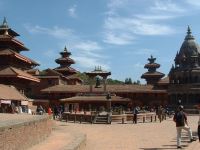
Patan
Officially called Lalitpur Metropolitan City, Patan is one of the three royal cities in the Kathmandu Valley. It has a rich cultural heritage and is known for its fine crafts, evident in the elaborate architecture, stone carvings, and metal statues found all over the city. Patan is actually one of the biggest cities in Nepal, with historic attractions mostly located near Durbar Square and best explored on foot. Patan Durbar Square is a good place to see beautiful examples of palaces, temples, and shrines, and stunning stone carvings of the Sundari Courtyards. The entire city of Patan was designated a UNESCO World Heritage Site in 1979 and is a centre of both Buddhist and Hindu culture in Nepal. Patan is home to more than 1,200 monuments, so tourists are spoilt for choice. One of the most stunning sites is the Krishna Mandir, a stone temple with magnificent friezes built in the 16th century. Other amazing temples include the Mahaboudha Temple, the Rudravarna Mahavihar, the Machchhendranath Temple, the Golden Temple, and the Kumbheshwar Temple. The Patan Museum is also a very popular tourist attraction.
Pashupatinath Temple
One of the most sacred Hindu shrines in the world, the UNESCO World Heritage Site of Pashupatinath is one of the major temples devoted to Lord Shiva on the Indian subcontinent. It attracts thousands of Hindu pilgrims each year, with Shiva being the patron deity of Nepal. The Temple of Pashupatinath is renowned for its beautiful architecture and stands on the banks of the holy Bagmati River, a tributary of the Ganges. Other temples, shrines, statues, and pagods surrounded this large temple complex, which can take some time to explore. The temple buildings are closed to non-Hindu visitors but the grounds are not. Shiva devotees and holy Hindi ascetics called sadhus roam the complex in great numbers, meditating and praying on the steps throughout the temple. One of the richest temples in Nepal, it received a great deal of wealth from kings and aristocrats in devotion to the god. The complex is also home to Kathmandu's funeral ghats, a series of cremation platforms spread along the river where the bodies of Hindus are burnt and the ashes scattered into the holy river. Tourists should be respectful when witnessing these cremation ceremonies and particularly cautious about taking photographs.
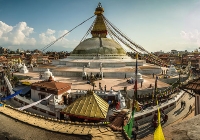
Boudhanath Stupa
The Boudhanath Stupa is the largest in the Kathmandu Valley, standing about 131 feet (40m) tall. It's one of the biggest and most important Buddhist stupas in the world. The all-seeing red, white, and blue eyes of the Buddha are painted on all four sides of the stupa, similar to Swayambhunath. Hundreds of fluttering prayer flags, prayer wheels, and small images of the Buddha surround the building. It is central to the Tibetan culture in Nepal and said to date back 500 years, although there is some debate about the exact date of construction. The Boudhanath Stupa is on the ancient trade route from Tibet to Nepal, and Tibetan pilgrims and merchants have been praying at the site for centuries. The influx of Tibetan refuges has led to more than 50 Tibetan monasteries built around the stupa. It's a UNESCO World Heritage Site and one of the most popular tourist attractions in Kathmandu. It is conveniently close to the city, located just 6.8 miles (11km) outside Kathmandu. Buddhist festivals cause a flurry of activity at the stupa, with thousands of pilgrims joining together in the sacred rituals, such as the Tibetan New Year, or Lhosar, in February every year.
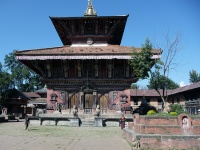
Changu Narayan Temple
Dedicated to the Hindu god Vishnu, Changu Narayan Temple sits on a ridge overlooking the Kathmandu Valley. Believed to be 1,600 years old, it's one of the oldest and most impressive examples of pagoda architecture in Nepal. The complex is a UNESCO World Heritage Site known for its incredible woodcarvings, metal inscriptions, and stone statues adorning the courtyard, all dating from between the 5th and 13th centuries. The complex is located on a high hilltop and surrounded by a forest and a small village called Changu. The views from the top are spectacular on a clear day and there are various shrines and sculptures in the extensive temple grounds, as well as vendors and artisans who offer comparatively well-priced and crafted souvenirs. The temple is a deservedly popular attraction but its location just outside of the city ensures it's not too crowded. There is an information centre at the entrance to Changu where tickets are issued and information about the temple and wider area is available. Those wanting refreshments will find a number of cafes and restaurants near the temple.
Eating Out
Kathmandu is chaotic and overcrowded, yet within its confusing borders lie many great restaurants. Thamel is by far the most popular restaurant district for tourists, where visitors can find a wide variety of international cuisines and restaurants to suit all budgets.
The local cuisine is invariably the best option, with Nepalese food tending to be popular with foreigners. The most popular traditional food is momo, a dumpling sometimes stuffed with various fillings or eaten as an accompaniment to all sorts of meals.
Curry is also a great specialty and comes in various forms. Chiya, a milky, spicy tea similar to Indian chai, is a wonderful traditional drink. Foreigners should note that the Nepalese only bring food to their mouths with their right hands and traditionally the left hand should not touch food.
Finding restaurants by address in Kathmandu can be difficult as street names and numbers are unreliable or non-existent. Hotels offer directions and sometimes guides, and friendly locals will also help locate eateries. Restaurants that have business cards usually include small maps on the back and they're worth keeping if visitors want to return.
Nightlife
Kathmandu is not famous for its nightlife, but there are options for those seeking some evening entertainment. Most of the nightlife in Kathmandu is based in Thamel and on Freak Street, and there are also quite a few bars to be found near Pulchowk in Patan.
By law, music isn't allowed to be played after 10pm but many bars and clubs stay open until later. In Nepal's capital, travellers are sure to find a venue to suit their tastes, whether it be a backpacker bar, trendy club, upmarket cocktail lounge, or cultural show at a traditional restaurant. Nightclubs in Kathmandu generally have a cover charge.
Travellers can also try their luck at one of the city's popular casinos or enjoy some live music. Noisy cover bands tend to be the order of the day, but New Orleans Cafe is a Kathmandu institution and is a good spot for some jazz and blues.
Getting Around
It's best not to use the public bus system in Kathmandu as buses tend to be crowded and unreliable, leaving only when full to bursting. If one isn't a seasoned traveller, taxis are available and usually found outside hotels and shopping centres.
Passengers should ensure the meter is on, although fixed prices are negotiable for sightseeing. Passengers should always agree on a fare before setting off if there is no meter, and ask at their hotel for guidelines on pricing, as drivers tend to overcharge tourists if they can get away with it.
Auto rickshaws ( ) are good options and usually operate on fixed routes, while pedal rickshaws are best only for short trips. Bicycles and motorcycles are hireable, but pollution, heavy traffic, and bicycle theft make these unappealing options, particularly as getting lost is easy in Kathmandu.
Self-drive car hire is not available and rented cars come with a driver. However, this is an expensive option and traffic is invariably heavy, making it slow going. It's actually better to negotiate the city on foot when possible, as it's often the least stressful way to get around and the best way to really experience daily life on the bustling streets.
Kathmandu Climate and Weather
The Kathmandu Valley is a warm, temperate zone that has a mild climate most of the year, and the city of Kathmandu, situated at an altitude of 4,297 feet (1,310m), has a mild, subtropical climate.
Between May and August, summer temperatures range from 67F to 81F (19C to 27C) and in winter, between November and February, temperatures average between 36F and 68F (2C to 20C). During the rainy monsoon season, between June and August, there is an average rainfall of between 7.8 to 14.7 inches (20 to 37cm) in Kathmandu.
May and June can be very hot and humid until the monsoon rains bring relief. In spring (March to April) and autumn (October to November), the temperatures are pleasant with occasional short bursts of rain, while November to February is dry but can be very cold, especially at night.
The best months to visit Kathmandu for a holiday are October to November and March to April, when the weather is warm and largely sunny, and the air is crisp and clear. Winters (November to February) are extremely cold, while early summer (May and June) is swelteringly hot and humid. Desired activities usually determine the best times to visit.
Nepal travel info
Electricity
Electrical current is 220 volts, 50Hz. Round two and three-pin plugs are used.
Language
Nepali is the official language. English is spoken in all major tourist areas.
Money
The official currency is the Nepalese rupee (NPR), which is divided into 100 paisa. Getting change can be a problem, so visitors should have a supply of small notes handy. Tourist activities are often quoted in US dollars and it is advisable to carry new dollar bills in varied denominations. There are ATMs in Kathmandu and Pokhara; Visa, MasterCard, and American Express credit cards are accepted in many tourist hotels, shops, restaurants, and travel agencies.
Banks and moneychangers are present in all tourist centres and major cities. All receipts from foreign exchange transactions should be kept so rupees can be exchanged back into foreign currencies on departure. Cash is needed when trekking.
Tipping
Restaurants and hotels may add 10 percent to bills, in which case no further tip is required. A 10 percent tip is otherwise customary in places that cater to tourists.
Health
Travellers arriving from infected areas require a yellow fever vaccination certificate. Malaria is a health risk between June and September in the low-lying areas of Nepal, including Chitwan National Park, but not in the common trekking areas. Travellers should consult their doctor about whether malaria prophylaxis is necessary. Outbreaks of Japanese encephalitis occur annually, particularly between July and December, and vaccination is advised.
Vaccinations are also recommended for hepatitis A, hepatitis B and typhoid. Those who will be in contact with animals, especially bats, may want to consider a rabies vaccination as well. Cholera outbreaks occur and food and water precautions should be followed. All eligible travellers should be up to date with their COVID-19 vaccines.
Untreated water must be avoided; visitors should buy bottled water or purify their own. When trekking it is preferable to treat river water rather than leaving a trail of plastic bottles behind. Purifying water with iodine is the cheapest and easiest way to treat water.
Altitude sickness is a real risk for trekkers, as many people suffer from altitude sickness above 8,202ft (2,500m). If symptoms persist it is wise to descend as quickly as possible. The standard of care in hospitals varies, but there are traveller's clinics in Kathmandu and numerous pharmacies in the major towns.
Medical insurance is essential, and should include air evacuation. All required medications should be taken into the country in their original packaging and accompanied by a signed and dated letter from a doctor detailing what they are and why they are needed.
Safety
There's a low rate of serious crime in Nepal, though visitors should take sensible precautions. They should watch out for pick-pockets and bag-snatching, particularly in airports, on buses and in areas popular with foreign nationals such as Thamel, Sanepa and Kupondol in Kathmandu. It's best to be cautious when walking around at night; assaults and robberies are more likely to take place in the evening in poorly lit areas. Travellers should avoid walking alone and carrying large sums of cash.
Demonstrations and public gatherings should be avoided as there is a risk of violence. Due to previous bomb attacks and shootings in public places, including the main tourist areas of Kathmandu, Pokhara, and Lukla, as well as on popular trekking routes, visitors are warned to be particularly vigilant.
There have been incidences of violent robbery against trekkers and there is an armed Maoist presence on many of the major trekking routes who demand a 'tax' before allowing trekkers to pass. Trekkers are advised to stay on established routes and walk in groups or with professional guides. Foreigners have been attacked in the Nagarjun Forest Reserve just outside Kathmandu and visitors are advised to be cautious in the area and to travel in a group.
Local customs
Nepal has numerous cultural practices that may be unusual for foreigners. In the tourist areas, there is a high degree of tolerance towards visitors but, away from these places, foreigners should be sensitive to local customs. They should never accept, offer, or eat anything with the left hand.
Visitors also shouldn't eat from someone else's plate or offer food from their own. Women should dress conservatively and cover up as much as possible. Permission should be sought before taking photographs, particularly at religious sites. Public displays of affection between men and women are frowned upon.
Doing business
The Nepalese are warm and friendly, and business is conducted with a combination of formality and sincerity, with a lot of time is given to small talk and socialising. Handshakes are fairly common but visitors should wait to see if a hand is offered.
Alternatively, a traditional namaste greeting, which involves a small bow accompanied by hands clasped as if in prayer, will be well received. Visitors should return the greeting if it is given. Dress tends to be formal and conservative, with suits and ties the norm.
Titles and surnames are usually used. The elderly in particular are treated with great respect and the word 'gi' is added after the name as a polite form. Punctuality is important, although it may take some time to get down to business, and negotiation can be a long process.
English is widely spoken and understood, but discussions in Nepali may occur between locals within a meeting. Business hours are usually 9.30am or 10am to 5pm, Sunday to Thursday. Closing time is 4pm in winter. Saturday is a holiday.
Duty free
Travellers to Nepal do not have to pay duty on 200 cigarettes, 50 cigars or 20g of tobacco, 1 litre of spirits or wine, or 12 cans of beer.
Communications
The country code for Nepal is +977, and the outgoing code is 00, followed by the relevant country code (e.g. 0044 for the UK). Visitors can purchase local prepaid SIM cards for unlocked phones; WiFi is available in cafes as well as most hotels and guest houses.
Passport & Visa
Most foreign passengers to Nepal can obtain a tourist visa on arrival in the country. These visas are valid for a maximum of 90 days, and cost between USD 30 and USD 125 (depending on the length of intended stay). Visitors should note that extensions of touristic stays (up to 150 days) can be arranged after arrival, by applying at the Department of Immigration in Kathmandu or Pokhara (fee: USD 20, plus an additional charge of USD 2 per day extended). All tourist visas are valid for Kathmandu Valley, Pokhara Valley, and Tiger Tops (Meghauli airport) in Chitwan. However, if travellers wish to visit other places, or trek in Nepal, permits can be obtained from the Central Immigration Office. Travellers should also note that passengers who need a visa for India, and who want to visit Nepal as well, should hold a visa valid for two entries into India; and that persons wishing to re-enter Nepal, and having in their passports any previous Nepalese visas cancelled (invalidated) by the Central Immigration Office, will be refused entry and deported. A yellow fever vaccination certificate is required.
Visitors should be able to get a visa on arrival if they can prove their COVID-19 vaccination status. People who have completed COVID-19 vaccination at least 14 days prior to entry to Nepal can get visas on arrival (they should bring proof of vaccination). Non-vaccinated people can also obtain visas on arrival but, if unvaccinated and aged over five years old, must be able to show a negative PCR test completed no more than 72 hours before the flight of first departure. Requirements are updated by Nepal's Department of Immigration, sometimes at short notice.
It is highly recommended that travellers' passports have at least six months' validity remaining after the intended date of departure from their travel destination. Immigration officials often apply different rules to those stated by travel agents and official sources.
Entry requirements
US citizens must have a passport that is valid for six months beyond their date of arrival in Nepal. A visa is required, and can be obtained on arrival for a maximum of 90 days.
British citizens must have a passport that is valid six months beyond their date of arrival in Nepal. A visa is required, and can be obtained on arrival for a maximum of 90 days.
Canadian citizens must have a passport that is valid six months beyond their date of arrival in Nepal. A visa is required, and can be obtained on arrival for a maximum of 90 days.
Australian citizens must have a passport valid for six months beyond their date of arrival in Nepal. A visa is required, and can be obtained on arrival for a maximum of 90 days.
South African citizens must have a passport that is valid for six months beyond their date of arrival in Nepal. A visa is required, and can be obtained on arrival for a maximum of 90 days.
Irish citizens must have a passport valid for six months beyond their date of arrival in Nepal. A visa is required, and can be obtained on arrival for a maximum of 90 days.
New Zealand citizens must have a passport valid for six months beyond their date of arrival in Nepal. A visa is required, and can be obtained on arrival for a maximum of 90 days.
Useful contacts
Nepal Tourist Office, Kathmandu: +977 (0)1 425 6909 or ntb.gov.np
100 (Police) and 101 (Fire).


